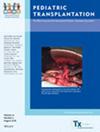体重指数对小儿心脏移植后运动能力的影响
IF 1.2
4区 医学
Q3 PEDIATRICS
引用次数: 0
摘要
背景心脏移植后肥胖和运动耐量受损会增加移植后发病和死亡的风险。本研究旨在评估体重指数对小儿心脏移植受者运动能力指标的影响,并将这一影响与健康小儿队列进行比较。所有患者均采用布鲁斯方案在跑步机上进行锻炼。纳入标准包括患者年龄在6-21岁之间,测试时有心脏移植史(移植队列)或无心脏病诊断(对照队列),并进行了最大努力测试。在这两个队列中,根据体重指数将患者进一步分为体重不足、正常、超重和肥胖四组。以诊断和体重指数类别为自变量进行了双向方差分析。结果 共纳入了 250 例心脏移植后的运动测试和 1963 例健康患者的运动测试。在所有体重指数组别中,心脏移植患者的静息心率较高,而最大心率、1 分钟心率恢复、运动持续时间和峰值有氧能力(VO2peak)较低。与体重不足和肥胖患者相比,体重指数正常和超重的心脏移植患者具有更高的VO2峰值和运动持续时间。体重正常和超重的心脏移植患者的运动能力指标最好。本文章由计算机程序翻译,如有差异,请以英文原文为准。
Effect of body mass index on exercise capacity following pediatric heart transplantation
BackgroundObesity and impaired exercise tolerance following heart transplantation increase the risk of post‐transplant morbidity and mortality. The aim of this study was to evaluate the effect of body mass index on markers of exercise capacity in pediatric heart transplant recipients and compare this effect with a healthy pediatric cohort.MethodsA retrospective analysis of cardiopulmonary exercise test data between 2004 and 2022 was performed. All patients exercised on a treadmill using the Bruce protocol. Inclusion criteria included patients aged 6–21 years, history of heart transplantation (transplant cohort) or no cardiac diagnosis (control cohort) at the time of testing, and a maximal effort test. Patients were further stratified within these two cohorts as underweight, normal, overweight, and obese based on body mass index groups. Two‐way analyses of variance were performed with diagnosis and body mass index category as the independent variables.ResultsA total of 250 exercise tests following heart transplant and 1963 exercise tests of healthy patients were included. Heart transplant patients across all body mass index groups had higher resting heart rate and lower maximal heart rate, heart rate recovery at 1 min, exercise duration, and peak aerobic capacity (VO2peak ). Heart transplant patients in the normal and overweight body mass index categories had higher VO2peak and exercise duration when compared to underweight and obese patients.ConclusionUnderweight status and obesity are strongly associated with lower VO2peak and exercise duration in heart transplant patients. Normal and overweight heart transplant patients had the best markers of exercise capacity.
求助全文
通过发布文献求助,成功后即可免费获取论文全文。
去求助
来源期刊

Pediatric Transplantation
医学-小儿科
CiteScore
2.90
自引率
15.40%
发文量
216
审稿时长
3-8 weeks
期刊介绍:
The aim of Pediatric Transplantation is to publish original articles of the highest quality on clinical experience and basic research in transplantation of tissues and solid organs in infants, children and adolescents. The journal seeks to disseminate the latest information widely to all individuals involved in kidney, liver, heart, lung, intestine and stem cell (bone-marrow) transplantation. In addition, the journal publishes focused reviews on topics relevant to pediatric transplantation as well as timely editorial comment on controversial issues.
 求助内容:
求助内容: 应助结果提醒方式:
应助结果提醒方式:


